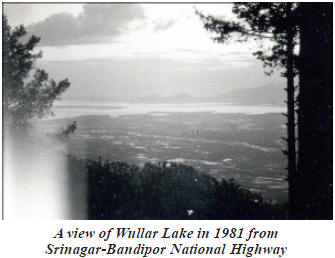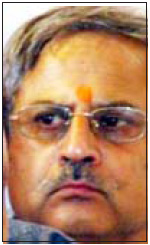Tales and Legends of Garoora, Chittibandhi and Tantraypora
By
Upender Ambardar
About
one and a half km. away from the village Aragam
lies Garoora village on it's western side. Garoora is a combination of
two Sanskrit words, 'Garoo' and 'Rah' meaning the
path or track of spiritual and religious guide. The village lore says that an
accomplished ascetic named Shankpaul used to do religious penance at the nearby
hill-top. He had twelve hundred disciples, who had exceptional devotion and
faith in him. In order to carry water required by 'Garu' for his day to day
religious rites, all the twelve hundred devotees would que in a line from the
hermitage at the hill-top upto the 'Garu Nag' lying in the nearby Wular Lake.
As per a belief, the 'Garu-Nag'
is said to be deepest part of the Wular Lake. In recognition of the
extraordinary reverence and devotion for the 'Garu', the way was called 'Garu
Rah', meaning Garu's path. With the passage of time, the very 'Garu-Rah' become
the present day Garoora village. The elevated part of Garoora village has a
pious and sacred spring known as 'Zaen-Mattan Nag', meaning being
equivalent to the famous holy Mattan spring of Anantnag (Kashmir). The 'Zaen-Mattan'
spring is believed to be invested with divine qualities and properties. It is a
big spring with a radius of about 14-15 feet. About six hundred years back it
had seven temples, made of chiselled stones of variable sizes, Sikander
Bhutshikan, the Muslim ruler of Kashmir is said to have demolished six temples
of the 'Zaen-Mattan' spring complex, while destroying the seventh temple, blood
is said to have flowed-out from it mysteriously. The King is said to have been
startled and frightened at the sight of this. This is how the seventh temple
escaped the fanatic ruler's wrath and fury.
The chiselled stones of those demolished temples are believed to have been
transported to 'Zainalank', the man-made island in the Wular Lake for the
construction of a temple for the 'pooja' of Shriyabhat, the famous minister of
the Kashmiri King Zaina-ul-Abidin. In addition to the temple, Budshah is said to
have built a mosque at Zainalank. The state government has presently constructed
a water reservoir at the holy 'Zaen-Mattan' spring and the surviving seventh
temple now remains hidden in the reservoir construction. The holy spring is
presently being used to supply water to the village Garoora and it's adjoining
areas. Garoora village has about 2,500 Muslim families but no Kashmiri Pandit
resided in the village at the time of their forced migration in 1990.
Chittibandi:
Adjacent to Garoora, is the
village of Chitti-Bandi, which means a place having plentiful untanned or light
coloured soil. A big stream runs through the village. It's main inhabitants are
Gujjar families. In addition to them, about a dozen Kashmiri Pandit families
resided in the village at the time of their migration in the year 1990.
The Pandit families of
Chitti-Bandi were those of Sh. Kashi Nath Bhat, Sh. Shivji Bhat
(presently at Bohri, Jammu), Sh Ved Lal Bhat (presently at Nagrota
Migrant Camp), Sh. Jia Lal (presently at Udaiwalla, Bohri, Jammu). Sh.
Pyare Lal (who runs a medical shop at Jammu) and Sh. Mukund Lal Bhat. All of
them were agriculturists and orchardists, some of them were also state
government employees. The village Chitti-Bandi has a small Shiv temple by the
side of a big stream called 'Boed-Koel'. All the Pandit families
had their houses in the vicinity of the said stream. A holy spring also existed
near the temple. Chitti-Bandi is about a half Km. from Aragam village. Paddy
forms the main crop of the village, while as apples, pears, cherry, peaches and
walnuts are the major fruit bearing trees.
Tantraypora:
Adjoining the village Aragam
at a distance of half a km is the village of
Tantraypora.
The village is adjacent to the cremation ground. A majestic Chinar tree growing
near the cremation ground is even today called as 'Tantar-Boien'.
In earlier times, Pandits well versed in tantric religious rites are said to
have resided here. The earlier name of the village is said to have been 'Tantarpur',
the name which proclaims it's past Hindu legacy.
Brar:
The village Brar is about 1½
kms from Aragam, while as Gund-Dachan village lies at a distance of about 2½ km
from Aragam. No Kashmiri Pandit family lived in these villages.
Pandits of Aragam and
adjoining villages celebrated a festival at the harvest time. A few freshly cut
rice panicles hung at the upper part of the main house door were believed to
ensure good harvest in the succeeding years. It used to be celebrated with a
sumptuous and lavish meal, comprising of mutton and water fowl preparations.
Another agriculture related
festival in vogue was known as 'Bal-Kadun'. In it cooked rice
along with a cooked fish piece kept at the barrier of the paddy field either on
Saturday or Tuesday was thought to guarantee protection to the crops fram the
pests and diseases.
Wular Lake:
Many fables and legends are
also associated with the Wular Lake, which is the
largest fresh water lake in Asia, being 16 km. long and 9.6 km wide. The
presiding deity of the lake is known as 'Wular Raz'. The lake is
said to have countless springs and the main spring is known as 'Neel Nag'.
It is regarded as the deepest part of the lake and is supposed to be in a state
of turbulence always. No boatman (hanji) even today dares to take his shikara
across this part of the Wular Lake. The folklore says that the presiding deity
of the lake known as 'Wular Raz' has his residence in the deep depths of the 'Neel-Nag'.
As per a legend, a saint in bygone ages is said to have weaved a rope
continuously for twelve years.
He is said
to have dropped this rope tied to a grinding stone in the Wular Lake to
ascertain it's depth but it is thought to have failed to touch the lake's
bottom. Another legend says that centuries back, a sage endowed with tantric and
supernatural powers once decided to take 'Wular Raz' into his custody. A boat
was engaged for the purpose and an oil lamp was lighted by him in the boat
amidst elaborate tantric rituals. He is said to have plunged into the 'Neel-Nag'
area of the Wular Lake after instructing the boatman to ensure continuous
lighting of the said oil lamp. The ascetic is said to have successfully emerged
out of the lake along with the 'Wular Raz', who was then kept in confinement in
the concealed part of the boat. The ascetic is believed to have dived again in
the lake to capture the rest of the family members of the 'Wular Raz'. In the
mean time, the Wular Raza enticed the boatman with the promise of unlimited
wealth if he extinguished the oil lamp. Tempted by the greed, the boatman
extinguished the lamp. As fall-out, the ascetic lost all his supernatural
powers and failed to emerge out of the lake.

Taking
advantage of it, the Wular Raz (the presiding deity of the lake) dived back to
be in his abode at the bottom of the 'Neel-Nag' of the lake. Instead of the
promised wealth, the boatman encountered a heap of charcoal floating on the
surface of the lake. Feeling betrayed and cursing his luck, he took a handful of
charcoal in his fire-pot for burning purpose. He rowed back to his home. Next
morning to his surprise, the charcoal in the forepart had turned into gold.
The
'Neel-Nag' and the 'Garu-Nag' (locally known as a 'Gor-Nag')
are supposed to exist at the extreme ends of the lake. As per the folklore, the
river Vitasta is aid to be the spouse of the Wular Raza.
Another
legend connected with the lake says that hundreds of years back, a boat carrying
a bridegroom got stuck-up near the 'Neel-Nag' part of the lake. The bridegroom
pleaded and request ed 'Wular Raz' to permit his Shikara to sail through and
promised to offer his spouse. After his return from the marriage ceremony the
bridegroom failed to keep his promise. As expected the Shikara failed to move
forward from the 'Neel-Nag' area of the Lake. Realising his mistake, the
bridegroom offered his just married spouse to the waters of the Wular Lake.
Shortly afterwards, to everbody's surprise the bride emerged from the depths of
the lake dressed-up in the celestial attire.
Even
today, no bridegroom can afford to annoy the 'Wular Raza', the presiding deity
of the lake while sailing across the lake. He without fail has to take off his
turban and keep the accompanying sword aside while crossing the Wular Lake.
People even now pay, salutations and obeisance to the 'Wular Raza' whenever they
happen to pass by the lake.
According
to one more legend, the present site of the Wular Lake is believed to have been
a flourishing city of affluence by the name of Sandimat Nagar, well
before the Christian era.
It's
inhabitants were so engrossed in the materialistic and worldly pursuits that
virtuous values and deeds were given a gobye. A sage advised the natives of
Sandimat Nagar to correct their way ward ways, otherwise he predicted an
enormous calamity for the city. Excepting for a potter, none paid any heed to
his sane advice.
The potter
not only entertained him but also gave shelter to him in his home. Out of
gratitude, the sage of his supernatural powers turned the potter's clay wheel
into gold. He also asked the potter to abandon the city and also cautioned him
not to look back while moving-out of the city. Next day, as advised the potter
along with his family fled from the city to seek shelter in the nearby upland
ridge. Immediately afterwards, the entire city was engulfed by enormous amounts
of water. Notwithstanding the warning of the sage, the potter looked back
compelled by the incoming screaming cries of the city inmates.

To his
surprise and horror, his fabulous and marvellous city had turned into a vast
lake, which is now known as the Wular Lake. As the potter had failed to honour
the promise not to look behind, half of the gold turned potter's wheel reverted
back to clay part.
The ridge
where the potter is believed to have taken shelter is even now known as
Watlab Sanger.
The
legends, tales and fables continue to be an integral part of our rich oral
history.
They are
proud relics of our past, though the degree of believability in them may vary.
They need to be preserved and protected so that they do not fade away into
obscurity.
Source: Kashmir
Sentinel
| 















No one has commented yet. Be the first!